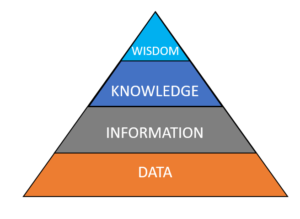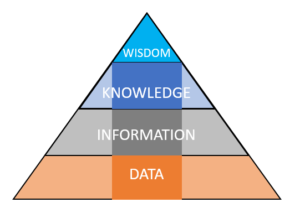There is a known pyramid based model that attempts to describe the relationship between Data – Information – Knowledge – Wisdom. I have reproduced the pyramid below.
Convention suggestions that one starts with Data, lots of it. You need to collect a lot of data before you can do anything else. Some of that data will be useless to you, but you need to collect it all before you know which is the ‘good stuff’ and which is the ‘rubbish’. The Pyramid is known as the DIKW pyramid *(don't try and say this out loud in the office!!!) https://en.wikipedia.org/wiki/DIKW_pyramid
Once you have a lot of data, you can then sift through the raw numbers and start to make assessments on it. We haven’t discussed what this data might be, and that is because this is really irrelevant to the model. The data might cover processor utilisation, it might cover datacentre occupancy, it might even cover the number of call centre staff on duty at any time. The key thing is that they are data values. By analysing this large volume of data, you can do the assessment that turns the data into information. For many people, this is the final step in their journey. They gain some level of information from their data and make bold pronouncements. It might be something along the lines of ‘most call centre people turn up to work 5 minutes late’ or ‘our data centre is 70% full’. The reason that this is the WRONG stage to stop at is because while you have information you don’t really have any knowledge about what is going on. Ask yourself the ‘so what?’ question. In the case of the datacentre being 70% occupied, the ‘so what?’ question would leads me to ask how much space we actually have? I would want to know whether that space is in contiguous lumps so I can actually use it for a new rack or storage array. You have Information, but no Knowledge.
Knowledge is gleaned from Information when you give it some context. If you can give the above statements context which is meaningful, then you are gaining knowledge:
- Most call centre people turn up for work 5 minutes late, and this means that we are missing our call handling SLAs during that initial 5 minute period.
- Our datacentre is 70% full and we have 200 U of contiguous space.
But we must still ask the question, ‘so what?’
If you finish your journey on Knowledge you will be the cleverest person in your organisation, and certainly the most informed, however you won’t have done anything to of benefit. That is where the Wisdom comes in. Knowing that something should be done to improve the business using the Wisdom that has been gleaned from the Information is the goal.
- Ensuring that all call centre staff arrive promptly will ensure that the business does not incur penalties from missed SLAs. You have the data to prove the issue, and the analysed information to show how the SLAs are currently being missed.
- Mapping the future demand for datacentre space against the known remaining contiguous space allows you to predict when an expansion to the datacentre facility will be required.
But my contention with all of the above model is the assumption that the journey MUST start with the data. I suggest that this is inefficient. If you don’t already have a rough idea of what problem you are looking to resolve, then you will waste a lot of time collecting irrelevant Data and doing unnecessary analysis to turn this into pointless Information. You wouldn’t collect data pertaining to call centre seat occupancy if you were hoping to end up with the Capacity Plan for Datacentre space. That’s obvious.
So why collect meaningless performance stats from your IT systems that you don’t even know how to analyse, or worse still have no place in your forecasting? As an example, while per process stats are really useful for diagnosing performance issues, it is the overall processor (and memory and storage) stats that are going to most beneficial for predicting when an upgrade to the infrastructure might be required. The process level information will be useful for building a capacity model, but there is little benefit in retaining 5+ years of per-minute stats. You’re never going to get around to analysing each and every minute, and there would be little substantive benefit in doing so.
Understanding what data to collect in the first place IS Wisdom. Having that Wisdom allows you to share your Knowledge of what analysis needs to be done within the Capacity team. If the team know what to analyse they have the Information to decide what Data to collect in the first place.
I contend that the pyramid makes more sense in an efficient business environment like this:
It looks very similar, but thanks to the benefit of having an expert on hand, you aren't wasting time and effort looking at the vast reams of Data that aren't within the value pathway to Wisdom.
I refer to this as the WKID pyramid. Now that is something that you CAN say in the office out loud without shame!
So I think you have to have someone in your organisation who can start the journey from the top (Wisdom) so that you are as efficient as possible. As this blog is titled..... One way... or another... and Debbie Harry knew.. I'm gonna getcha!


